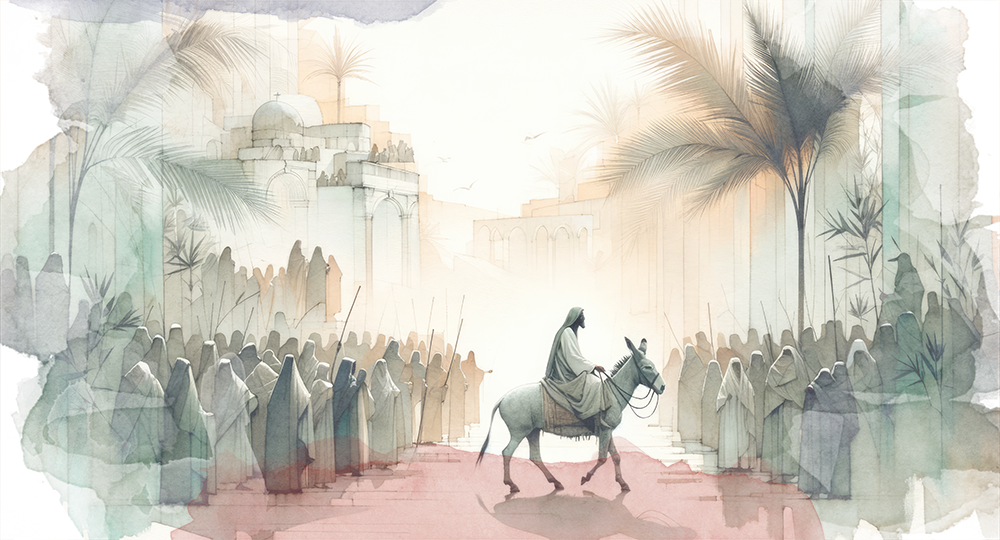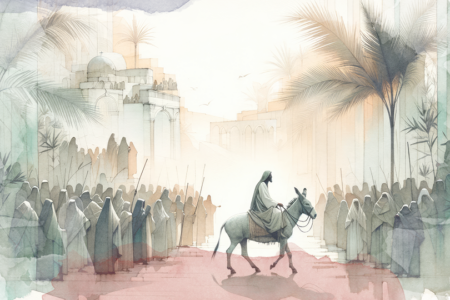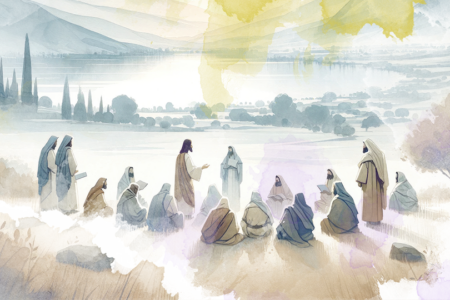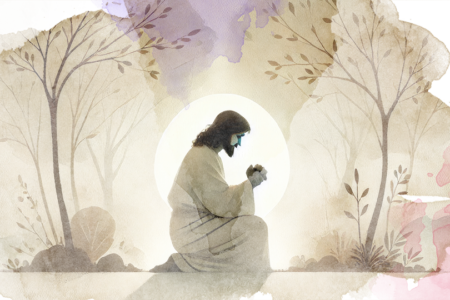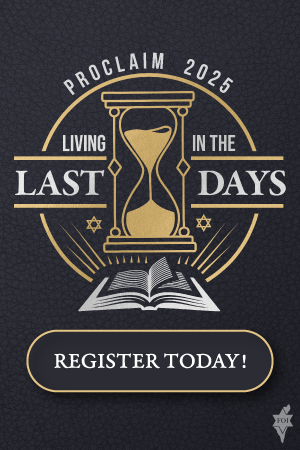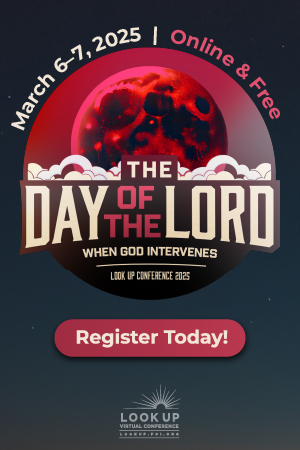The Ultimate Passover Lamb
When Jesus entered Jerusalem on the foal of a donkey shortly before His crucifixion, more was transpiring than met the eye.
The Gospels—Matthew, Mark, Luke, and John—offer a comprehensive look at Jesus’ last week on Earth, and all four tell of His entering Jerusalem on the foal of a donkey. Yet, each Gospel’s focus is slightly different. Matthew wrote for his Jewish brethren, knowing they would understand much of the imagery he used; and his perspective gives insight into what ethnic Israel needs to understand concerning its Messiah.
Jesus was about to enter the Holy City, where He would be unjustly accused, crucified, and buried—only to rise triumphantly from the dead on the third day. Prior to His memorable entrance into Jerusalem, He visited the home of Simon the Leper in Bethany, where a woman named Mary anointed Him with extraordinarily expensive perfume (Mt. 26:6–13). John’s Gospel places this event six days before Passover (Jn. 12:1).
Both Matthew’s and John’s Gospels record Judas’s disgust at Mary pouring the perfume on Jesus. As treasurer for the 12 disciples, perhaps he imagined himself treasurer in Jesus’ Kingdom—no doubt for his own nefarious, self-serving benefit because he was a thief who stole from the money box (v. 6).
However, Jesus defended Mary, telling everyone she had anointed His feet “for the day of My burial” (v. 7; cf. Mt. 26:12). Perhaps she alone understood Jesus when He spoke of His upcoming crucifixion and burial. Clearly, Mary’s was an act of sacrificial devotion that would be remembered forever. Jesus noted that fact:
For in pouring this fragrant oil on My body, she did it for My burial. Assuredly, I say to you, wherever this gospel is preached in the whole world, what this woman has done will also be told as a memorial to her (Mt. 26:12–13).
The significance of this account should not be overlooked. What would take place within days must certainly have reminded the disciples of what Mary had done.
An Unmistakable Fulfillment
After leaving Bethany, Jesus and His disciples made their way to Jerusalem, stopping first in the small village of Bethphage. Matthew 21:1–5 records Jesus telling His disciples to locate a donkey and her colt and bring them to Him. The Gospel of Mark includes the following narrative:
“And if anyone says to you, ‘Why are you doing this?’ say, ‘The Lord has need of it,’ and immediately he will send it here.” So they went their way, and found the colt tied by the door outside on the street, and they loosed it. But some of those who stood there said to them, “What are you doing, loosing the colt?” And they spoke to them just as Jesus had commanded. So they let them go (Mk. 11:3–6).
Why are these details included in the Gospel record? Because the significance of this sovereignly appointed event is found in Zechariah 9:9: “Rejoice greatly, O daughter of Zion! Shout, O daughter of Jerusalem! Behold, your King is coming to you; He is just and having salvation, lowly and riding on a donkey, a colt, the foal of a donkey.” It also echoes Isaiah 62:11: “Say to the daughter of Zion, ‘Surely your salvation is coming.’”
In ancient times, leaders rode horses to war; but they rode donkeys if they came in peace. King David issued a directive that his son Solomon ride on David’s own donkey when he was anointed king. Other accounts reflect this practice as well (Judg. 5:10; 10:4; 12:14; 2 Sam. 16:2). It is no wonder that when Jesus entered Jerusalem on the foal of a donkey, in fulfillment of Zechariah 9:9, “a very great multitude spread their clothes on the road; others cut down branches from the trees and spread them on the road” (Mt. 21:8).
Scripture says, “Then the multitudes who went before and those who followed cried out, saying: ‘Hosanna to the Son of David! “Blessed is He who comes in the name of the Lord!” Hosanna in the highest!’” (v. 9).
An Intentional Parallel
The joyous day Jesus entered Jerusalem was the 10th of Nisan on the Jewish calendar—the day the Passover lambs were set aside for public examination:
On the tenth of this month every man shall take for himself a lamb, according to the house of his father, a lamb for a household. Your lamb shall be without blemish, a male of the first year. You may take it from the sheep or from the goats. Now you shall keep it until the fourteenth day of the same month. Then the whole assembly of the congregation of Israel shall kill it at twilight (Ex. 12:3, 5–6).
The purpose of observing the lambs was to ensure they were spotless and without blemish. The parallel seems obvious. The apostle John called Jesus “the Lamb of God who takes away the sin of the world” (Jn. 1:29), and the Gospels record Him presenting Himself in Jerusalem for examination on the very day the Passover lambs were put on public display.
Just exactly what was intended by this event? Bible scholar Dr. Arnold Fruchtenbaum offered this insight:
Yeshua offered Himself as the Messiah, the King of the Jews, during the previous three years. Israel rejected His Messiahship about one-and-a-half years earlier (Mt. 12:22–45). . . . The purpose of this ride into Jerusalem was not to officially present Himself as the King, something He had done all along. . . . Just as on the tenth day of Nisan, the Jews set aside the literal lamb, on this same day, Yeshua rode into Jerusalem and was set aside as the Passover Lamb of God.1
A Mistaken Expectation
Without a doubt, the Jewish people longed for a military deliverer—a Messiah-King who would deliver them from Roman rule. Many cried out, “Hosanna! ‘Blessed is He who comes in the name of the LORD!’ Blessed is the kingdom of our father David that comes in the name of the Lord! Hosanna in the highest!” (Mk. 11:9–10).
Upset, some of the Pharisees demanded Jesus rebuke them. He responded, “I tell you that if these should keep silent, the stones would immediately cry out” (Lk. 19:40).
Though Jesus’ response seemed to justify the crowd’s outcry, the events that followed and His sacrificial death revolved not around Him assuming His place on King David’s throne but, rather, on Him willingly assuming His place on the cross in fulfillment of Isaiah 53.
Jesus offered the Kingdom to Israel—but that offer was rejected; and He offered Himself as Messiah, but He was crucified. Both these events were foreordained and foretold centuries earlier in God’s eternal Word.
Hope and Peace
The truth of Jesus as Israel’s Messiah offers a future hope for God’s Chosen People. In his book The Coming Kingdom, Andrew Woods quotes Stanley Toussaint and Jay A. Quine concerning Israel’s rejection of the Kingdom offer: “This does not mean Christ stopped presenting Himself to Israel as their Messiah. He did this, particularly in His triumphal entry, but the die had already been cast. The kingdom was no longer near.”2
Yet, God’s redemptive plan has not been thwarted. In the last days, Messiah Jesus will return and fulfill all His promises to Israel. (See Daniel 2:44–45 and Revelation 19:11—20:10.)
Jesus’ offer of Himself as the Passover Lamb holds a message of peace and hope. One day Israel will enjoy unprecedented peace when its Messiah reigns. But individuals can know true peace today when they accept the gracious gift of God’s only begotten Son who gave His life that we can have peace with God (Rom. 5:1–2).
God’s Word guarantees both hope and peace to all who acknowledge their sinfulness and place their trust in Messiah Jesus alone for their salvation. In His First Advent, Jesus came as the Lamb of God, slain for sin. In His Second Advent, He will come as the Lion of Judah. “And He will reign over the house of Jacob forever, and of His kingdom there will be no end” (Lk. 1:33).
ENDNOTES
-
-
- Arnold G. Fruchtenbaum, Yeshua: The Life of Messiah from a Messianic Jewish Perspective (San Antonio, TX: Ariel Ministries, 2022), 417–418.
- Stanley D. Toussaint and Jay A. Quine, “No, Not Yet: The Contingency of God’s Promised Kingdom,” Bibliotheca Sacra 164 (April-June 2007), 141, cited in Andrew M. Woods, The Coming Kingdom (Duluth, MN: Grace Gospel Press, 2016), 65.
-
Photo: Adobe Stock
